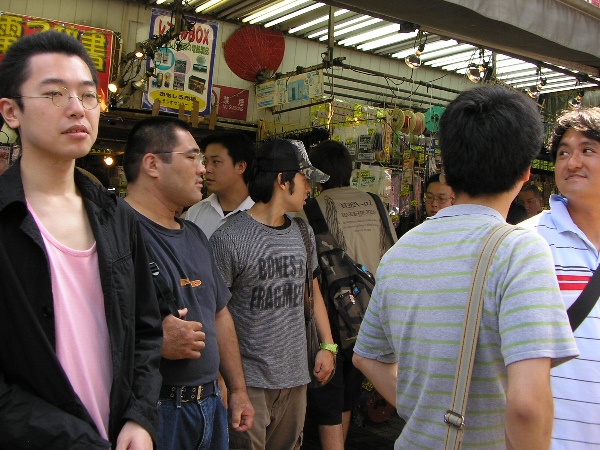
朝11時、OTAKUの街秋葉原に行く。
2年振りにアストン大学で一緒だったTakekiさんと待ち合わせる。
自称 「元オタク」の彼がサムと僕を案内してくれた。
実の所秋葉に来たのは今回が僕も初めて。
実に興味深い街だった。
コスプレをしている人が多い。
ストーム・テュルーパー(スターウォーズの)が買い物をしていたりする。
街を歩きまわる前に、サムにOtakuの定義とその見分けかたを教えてあげた。
「Otakuというのは、何かにもの凄く夢中になっている人のことを言うんだよ。特に
日本のOtakuは、アニメやパソコン・AV機器関係に夢中になる傾向があるんだ」と定義し、
さらに、リュックを片手で手提げのように持っている人、
折りたたみ傘がリュックからはみ出している人、等と、通りかかるオタクっぽい人をみつけては、オタクの特徴性を具体的に説明したあげた。
At 11am, we went to Akihabara, the town of OTAKUs.
We arranged to meet Takeki, it's been more than two years since I last saw him.
Takeki, who admits being an OTAKU himself in the past showed us around the streets of Akihabara.
This was actually my first visit to this town.
There are a lot of people dressed in interesting clothes.
For example, I spotted a storm trooper (from Starwars) shopping in a store.
Before we walk around the city, I taught Sam the definition of OTAKU and how to identify them.
But defining the word OTAKU is as difficult as difining the meaning of life, but I tried by saying
"An otaku refers to someone who is extremely preoccupited with something,
in Japan, the object of preoccupation tends to be animation, computers or audio visuals".
And using the passersby as real life examples, I taught him that people holding a backpack with one hand,
a person whose collapsable umbrella is sticking out from the backpack are very likely to be otakus.
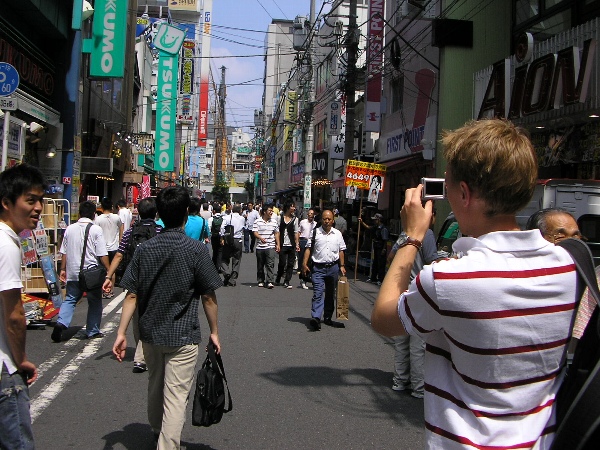
Takekiさんが、この自動販売機を紹介してくれた。
なんと、缶詰にラーメンが入っている。隣にはおでんが入ったのもあった。
Takeki showed us this very interesting vending machine for noodles...
Who would want to eat noodles in a can I wonder...

このネクタイ、USBでパソコンにつなげると、ネクタイが風が出てくる。
暑い夏にはかかせないアイテムだ!
クール・ビズもここまでくると、かなり怪しいオタクの領域だ。
This tie, called "USB neck-tie cooler" was ingenious.
When you plug it into an USB port in your laptop, the fan will move and cools you down.
It's an indispensable item during summer.
I guess this is how otakus practice their "cool biz".

そして、Takekiさんと話し合い、サムを今流行り(?)の、メイド喫茶に連れていくことにした。
さすが、自称元オタクのTakekiさん、しっかりと場所が分かっていた。
サムは何か勘違いしていたらしく、いつものサムと表情が違ったからウケた。
「おかえりなさいませー」と言われたときは、さすがに僕もひいた。
極めつけは、店を出る時の「いってらしゃいませー」だ。
後で、メイド喫茶の感想をサムに聞くと、「表現できない(indescribable)」と言っていた。
I discussed with Takeki and decided to bring Sam to a "maid-cafe", a type of cafe recently becoming very popular in this city.
Of course, Takeki, as an ex-otaku, knew where it was.
Sam seemed to be misunderstanding something and his facial expression seemed a little different than usual.
Well, I did feel a bit spooky when this "maid" goes, as we enter the cafe, "Okaeri-nasai mase (meaning welcome home master)".
And to finish us off, when we left the cafe, they go "Itterashai mase (have a nice day master)".
"indescribable", was Sam's comment about the place.
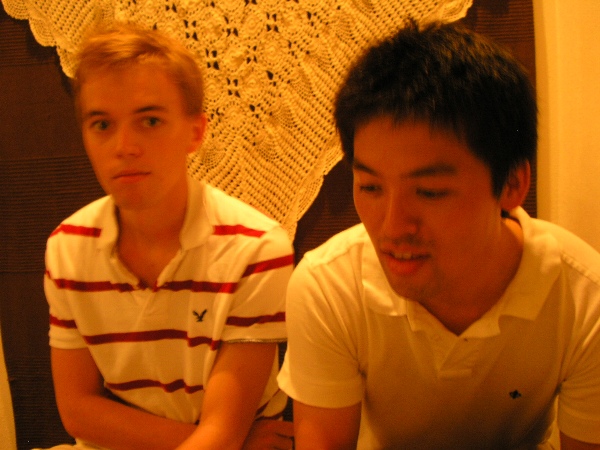
このような、メイドさんがこの街には至る所にいる。
「どうして、メイドの格好をしているのだ?」とサムに聞かれ、Takekiさんとかなり困った。
そもそも日本のソフトカルチャーは、日本の何千年もの歴史を経て少しづつ育ってきたわけで、そう簡単には説明できない!
「アニメのキャラと現実社会において、出会ってみたい願望をもった人がいるんだよ」と適当に答えておいたが、
サムは納得していなかったようだ。
This kind of women dressed as maids are everywhere in this city.
"So why are they dressed like that" asked Sam.
Me and Takeki struggled to answer this question.
To begin with, Japanese so-called "soft-culture" has developed throughout thousands of years and it is not possible to summarise the current phenemonon,
as it is an ongoing process (rather than the result) that changes constantly.
So I answered
"There are some people who want to meet in reality with some characters from the animation".
But Sam seemed not satisfied with this answer.
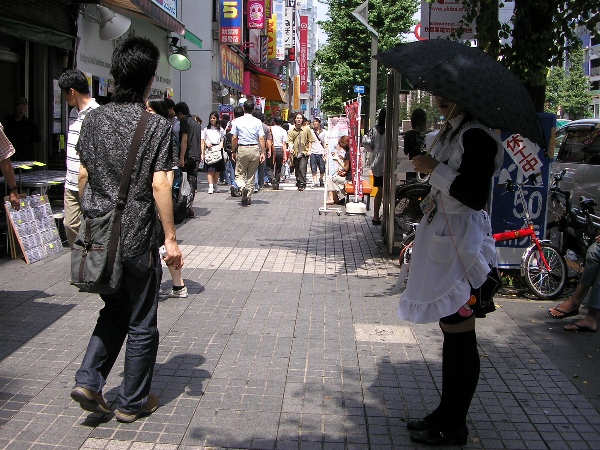
さて、秋葉原と言えば、オタク以外には、やはり電気屋だ。
巨大なヨドバシカメラにサムを連れて行き、日本のエレクトロニクス産業の強さを見せてあげた。
これほどの規模の店は世界にどこにもないだろう。
Well, Akihabara is not just the city of Otakus, but it actually has the largest number of electronic stores in Japan (perhaps in whole of world).
We went into one of them called Yodobashi-Camera and showed Sam the power of Japan's electronics industry.
I bet there's nothing like this anywhere in the world.
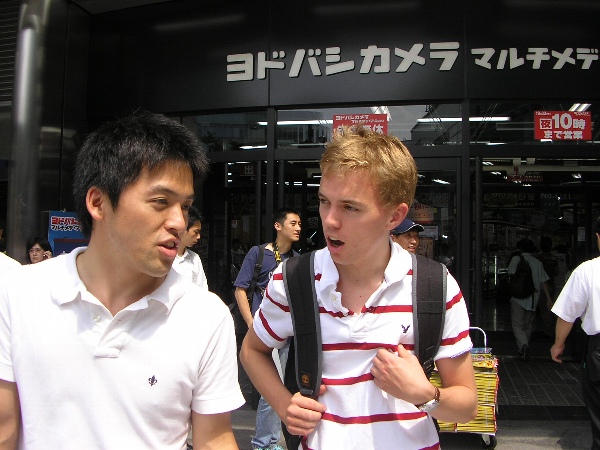
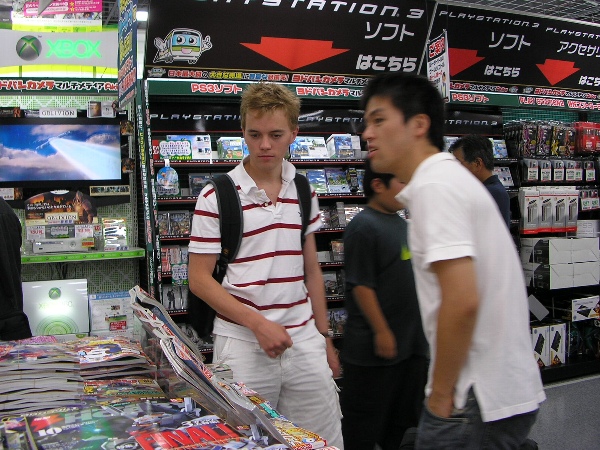
さて、秋葉原で異文化体験をした後、電車に乗り、原宿へ向かった。
原宿の竹下通りを歩く。
この通りで唯一覚えていることと言えば、死ぬほど暑かったということだ。
From Akihabara, we got on a train to Harajuku, a young people's town.
We walked down Takeshita-douri, a very famous fashion street for young people.
The only thing I can remember in this place is that it was damn hot.
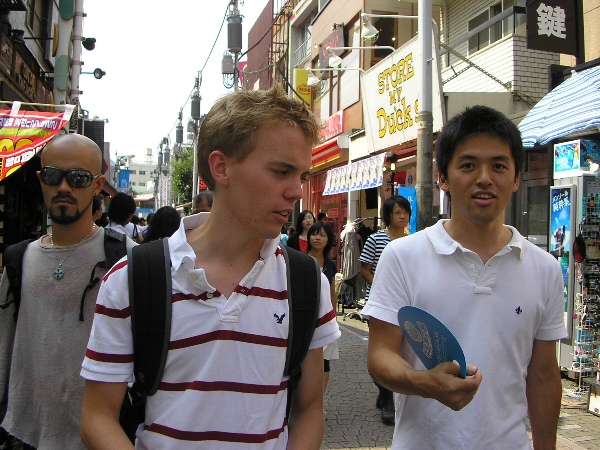
原宿から渋谷へ歩いて向かう。
From Harajuku, we walked to Shibuya, another young people's town.
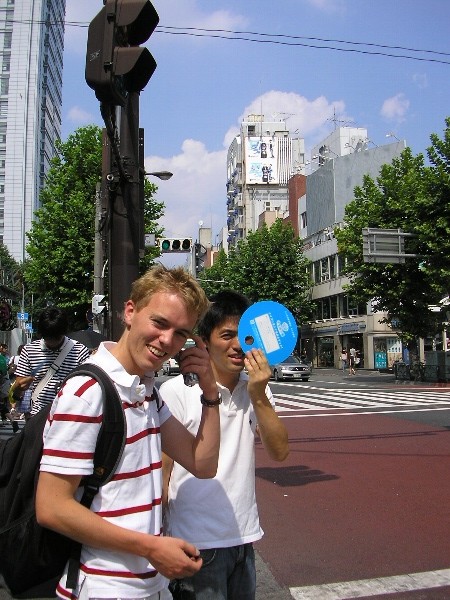
表参道
オタクに続いて、原宿にはまた一風変わった格好をした人々がいるとサムに教えてあげた。
こう思うと、東京は、場所によってそれぞれ全く違った文化があるような気がする。
Omotesandou's crossings.
I told Sam that Harajuku has got another type of weird people (dressed in black and eccentric clothes).
To think about it, Tokyo is fully of weird people,
and each area has totally different atmosphere.
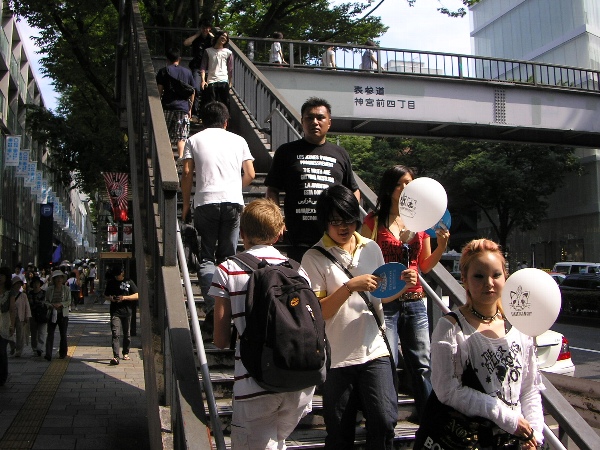
表参道の近くにある餃子屋で昼飯を食べる。
クーラーがほとんど効いておらず、食べる度に汗がでる。
We ate gyouza near Omotesando.
The air-conditioner wasn't effective in this store (as gyouzas were continuously being cooked in front of us) and we were sweating pretty heavily.
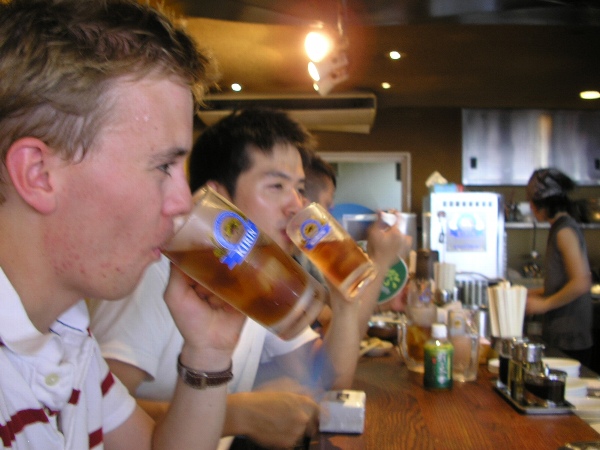
Takekiさんお勧めのこの餃子屋はなかなか美味かった。
This gyouza restaurant was a good choice made by Takeki.
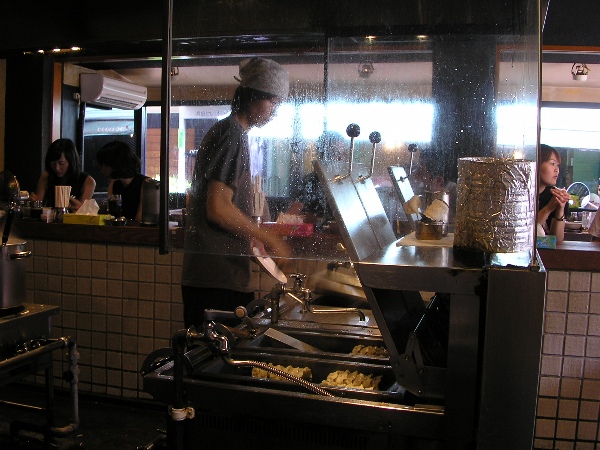
表参道から渋谷へむかう途中で、UTというなかなかセンスの良いTシャツショップがあった。
サムも自分用と、妹へのお土産用に一枚づつ買っていた。
Along the way from Omotesandou to Shibuya, we found this cool T-shirt shop called UT.
Sam bought two of them, one for himself and one for his sister.
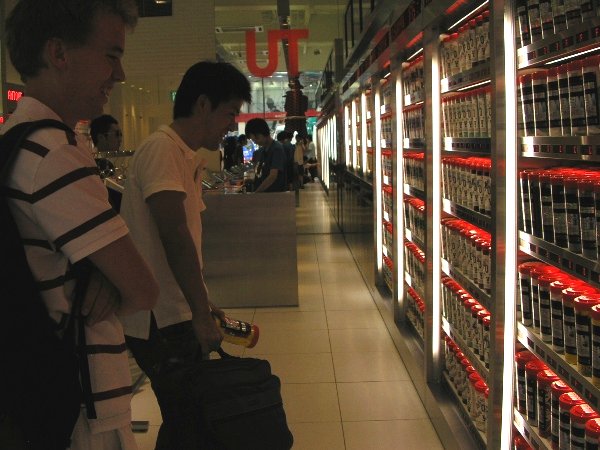
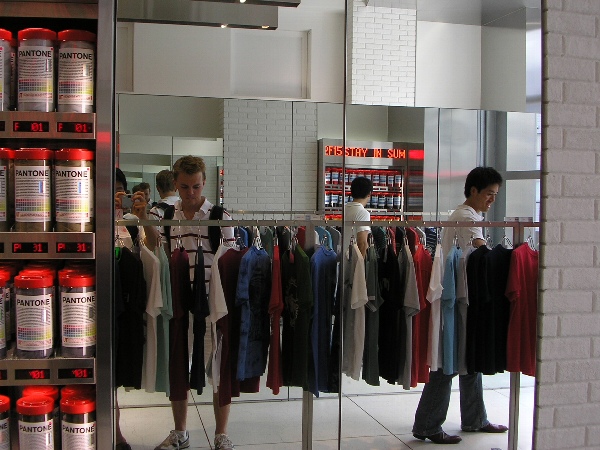
渋谷のこの巨大な交差点は、映画でよく登場するということもあって、外国ではとても有名なスポットだ。
This pedestrian crossing in Shibuya is very famous among the foreigners, as it was used in several western films.
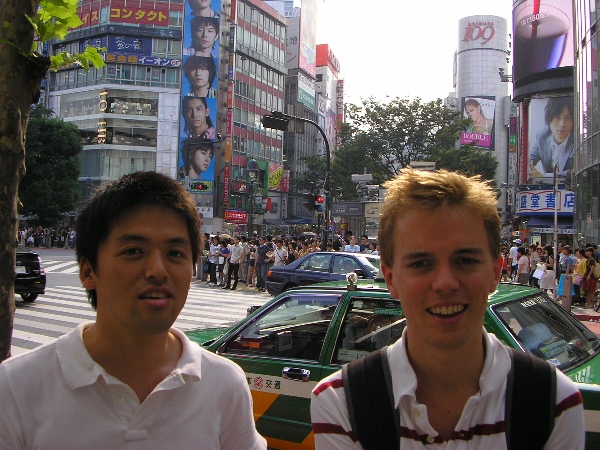
人がまるで、働き蟻のように、うごめいている様子はとてもインプレッシブだ。
People are walking to different direction like ants.
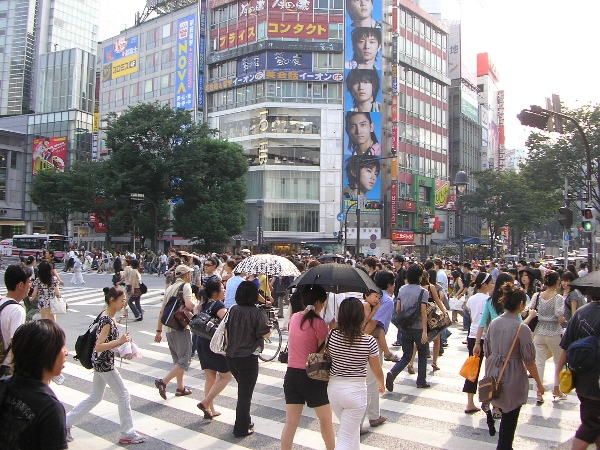
夜、サムを実家に招いた。
一緒に寿司などを食べた。
We invited Sam to our house for dinner.
We had sushi and stuff.
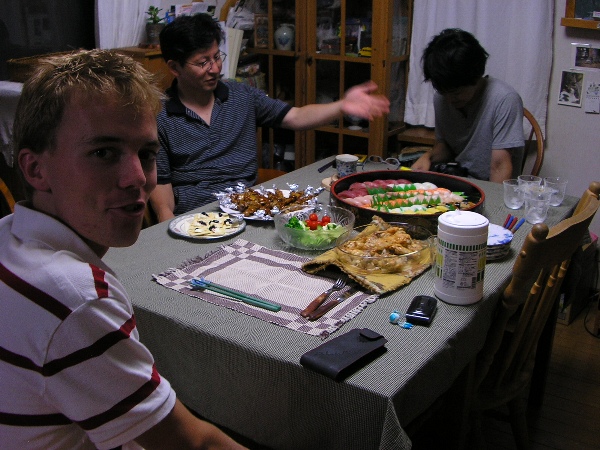
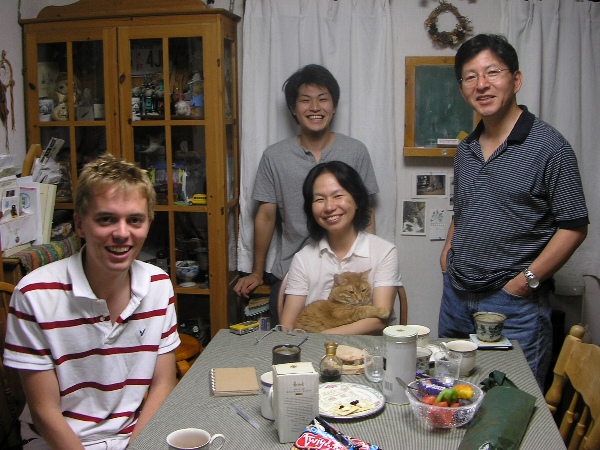
Yesterday Tomorrow
1 year ago
2 years ago
3 years ago